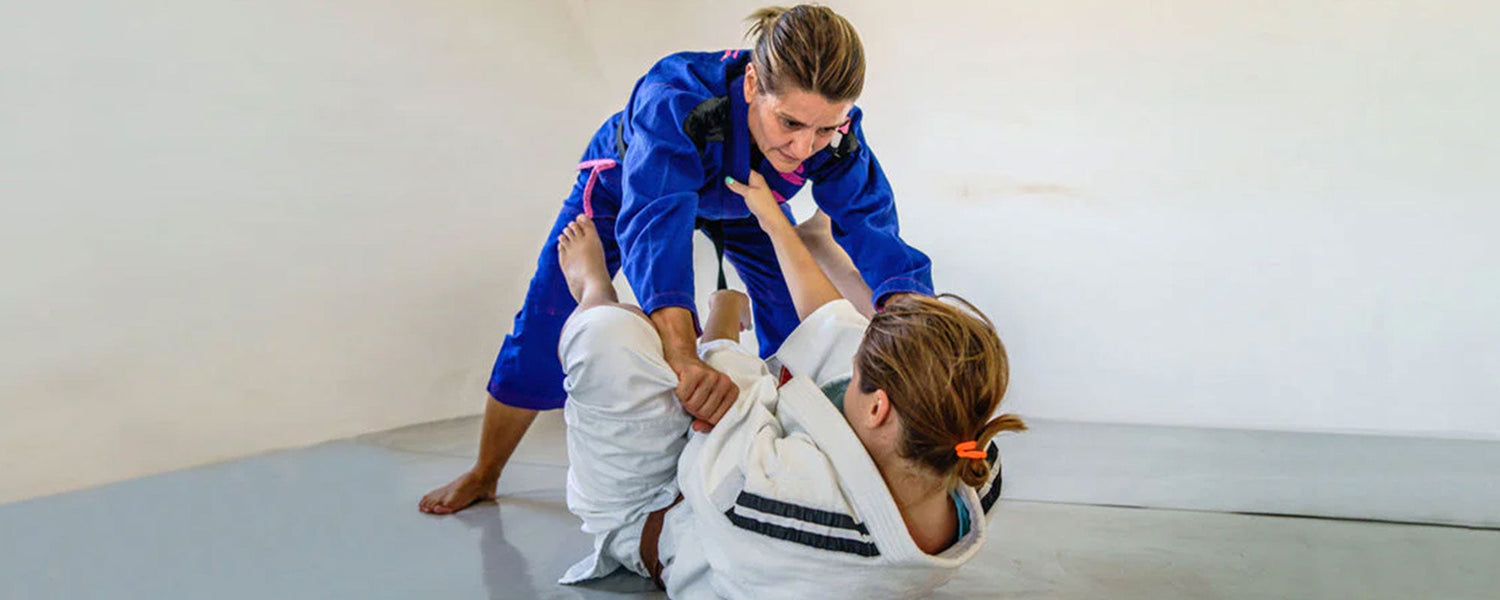Table of content
Among many other martial arts disciplines, Brazilian Jiu Jitsu has a separate fan following and is becoming the future face of MMA. There are multiple techniques in BJJ among them guard passing is one of the key techniques that help you avoid an opponent's attack and place counters to get an advantage during a fight. Therefore, it is important to learn and practice this technique to stay at the top. Experts say that if you are skillful to guard and pass your opponents, no one can beat you in this sport.
Guard passing is not limited to a single method to get out of the opponent’s guards. There are multiple variations in guard passing technique that you can use to do so. To help you get the best at guard passing, we will be discussing some of the best jiu jitsu guard passing drills. So, get ready wearing your BJJ gear, practice the following guard passing drills and defend yourself successfully from getting submitted from your opponents.
The Best BJJ Drills for Guard Passing
1. Toreando Guard Pass Drills
Toreando pass is one of the basic and most common guard passing methods that you witness if you train BJJ Gi. Performing and utilizing perfectly is what helps you in improving your guard passing skills. For that, it is essential to practice this guard passing technique. For which, there are multiple drills owing to numerous variations of this technique. Therefore, we will discuss drills for each of its variations as follows.
1.1. Knee on Belly
The knee on the belly is one of the common toreando passes that can be used whenever you find your opponent is not sitting up or is not so quick as they need to do to stop you from getting in position to place your knee on the belly. To be efficient in the knee on the belly for guard passing, it will be vital to practice it with the help of a partner.
How to Practice?
The best way to practice this knee-on belly toreando guard passing technique is to design drills to include in your brazilian jiu jitsu training. This is basically about getting a position to put your knee on the opponent's stomach or belly.
You can practice it by laying your partner down on the mats in a guard position and sitting on them in a mount position. From this position, you dismount to the side while placing your knee on your partner's belly.
1.2. Throw Past
Throw past is another outstanding version of toreando guard pass which is quite useful in a situation where a person is sitting up and is about to go for a butterfly guard. You start by pinning the opponent’s knees to their chest. This is like taking the slack out of your opponent’s legs, however, this is beneficial to reach the opponent's range of flexibility to end up in a spider guard. The opponent will push you back, at the same time you have to drag their legs out.
How to Practice?
To practice throwing past versions of toreando guard pass you have to have a partner who knows BJJ basics and gets into any guard position. Your partner will lie on the mat in a guard position and you have to grip their gi from knee point and throw past their legs on either side.
1.3. Leg Drag
Leg drag is the advanced version of the throw past guard pass that is used to control an opponent's hips before they advance for guard passing. You start this in the same way you do throw past but the difference is that when your opponent pushes outward, you create a shelf with the help of your lead leg for the opponent's leg to rest on. Now it becomes the matter of keeping your opponent’s leg away from you while weighing down and taking care of the tight space.
Why People Could Not Perform It Well?
There are multiple reasons for this issue people face during their jiu jitsu fights. One major reason is lacking practice for this guard passing technique or misunderstanding the steps of it. Therefore, planning drills of this toreando guard passing technique is the best step that you can take to be efficient when it comes to applying it in actual fights.
1.4. Knees-In Version
The version of toreando that you may see applying most of the grapplers in recent years is knee-in. This is about pinching the opponent's knee close to their chest by pressuring forward that forces them to push you back at some point that allows you to guard past them by sidestepping.
You can formulate a 10-minute drill including 2-minute intervals followed by a 60 second resting period after each. For this drill too, you need a partner. You will perform this technique in the described way, however, you can use your position to go for a knee on the belly or any mount position.
1.5. Hip Switch Knee Drop
If you have a strong guard recovery, hip switch knee drop is one of the great moves that you can use to your advantage in a fight. In this technique, you hip out the right as soon as you are into your guard. In this technique, you do not have to resist the motion but go with it entirely in order to utilize the power that your opponent is putting in. Once you are done with causing them an inevitable overreach, it is time to drop your knee to the ground. This is how you execute this move for guard passing.
You can drill this technique with the help of a partner who is all aware of the BJJ techniques and the right time to tap out. You can formulate this drill according to your ease and your endurance level.
1.6. Side-Control Shoulder Smash
Side control shoulder smash is the oldest guard passing technique that you see BJJ fighters utilizing in their fights. You start this move in a standing position when your opponent is in a seated position. You have to grab the inside of their pants and straighten your arms to bring your knees together to lock your arm utilizing your body weight for pinning your opponent’s feet to the ground. When your opponent tries to sit up, you should walk around to their sides to drive your shoulder to their chest area which will ultimately flatten them. Now you should switch to 100 kilos for finishing the pass.
What You Should Be Considering?
You should be practicing this technique for enough time to get the best at it to use when it comes to actual fights. Your partner should be aware of all steps of this technique to assist you in the right way. They should also know when to tap to avoid any kind of strain due to any uncontrolled use of pressure while performing this technique.
2. Over Under Pass Drill
Over underpass is a pressure-based pass that has been developed by Bernardo Faria. If you do not know the mechanics behind this pass, it is very hard for you to defend. This is one of the best ways to guard pass as it helps you prevent your opponent from going to establish the guard.
This guard passing technique comprises two critical parts that are hip mobilization and pressuring the lower body. In this technique, you establish leg control by positioning yourself under one leg and over another leg while applying the pressure with your shoulder on your opponent’s stomach and hip. Your head should also be glued to your opponent’s hip while executing this guard pass.
2.1. Mistakes to Avoid
To maximize your efficiency in this guard passing technique you must be aware of the most common mistakes that many people make, so you should not be committing the same.
The first one is getting open for a kimura attempt by the opponent on your arm. However, this is easy to deal with if you are holding their pants or foot solidly and your elbow is in, your opponent will not be able to go for it. Even if they try, they are allowing you to pass the guard with more ease. The right weight distribution also restricts opponents from doing so.
The other common mistake is giving up on this guard passing technique due to resistance from the opponent by posting on to the body or head. This problem takes place due to having your head up. If you place yourself in the right position on the opponent's belly, your head will remain low.
One thing that you should also keep in mind is that over-under-passing is based on putting pressure which means that you should go slowly and patiently when it comes to applying it to your opponents.
3. Double Under Pass Drill
The double under pass is one of the most essential tools for any BJJ practitioner to have in their arsenal. This is one of the fundamental techniques that allow you to get around the opponent’s leg and is used by all from white belts to black belts.
The Best Way to Enter into the Double Under Pass
The best way to enter into the double under pass is to start by opening the closed guard. It will allow you to enter into a combat base position to be able to enter into any of the ways to pass the guard. To open the guard, start by dividing both arms underneath the opponent’s hips specifically if their legs are off the ground. Lead with your elbows instead of your hands while doing so to avoid a possible triangle choke. Now clasp your hands firmly at the wrists. Use your combat base knee for propping up your opponent’s hips off the ground while grabbing their lapel with the same hand. Now apply the pressure to ensure that your opponent’s knee is touching their nose. Finish it by pressing your chest forward and clearing the opponent’s legs off to the side.
3.1. Some Useful Tips
- While performing a double under pass, your arms should be working together. Do not go with one arm as it can result in being triangle choked.
- Make sure your opponent’s legs are way up on your shoulders at the time when you get your hands clasped together.
- Make sure that you can keep your opponent’s hips off the ground when you go to elevate them by placing your lead knee under their hips.
- Using a kickstand for driving your weight forward can help you ensure that the “knee in the nose” effect is working well.
- Once you are done with guard passing, stabilize your position before attempting for a finishing submission.
4. Duck Under Pass Drill
A duck underpass is a technique that prevents you from getting in a berimbolo. You can pass this guard position by gripping the lapel of your opponent with your left hand very low to their hips when they try to set it up by cross gripping on your belt. You use your forearm to ensure that your opponent’s arm is not following you. Now you will be using your left arm to duck your head under the opponent's leg. Going this way will surely help you get your head on the other side of your opponent’s leg. When you reach there, stay tight with your ear to follow your head while swinging your right arm underneath. If you get in this position, now you have the opportunity to go for a leg drag guard pass which is described above.
5. Leg Staple with Back Step Drill
Leg staple is one of the very basic guards passes that people learn in judo and jiu jitsu. You start this guard passing technique by opening the guard and getting into a combat base position. Now the first step to take is dropping down the knee of your opponent and making them unable to go for shrimping or hipping out. As soon as you do so, you can pin their thigh with your leg while keeping your foot inside of their thigh. Now lift your right knee a little up in order to prop up the opponent's left leg to prevent yourself from most of the counters they make against this technique.
Now the next thing that you should be doing once you have used leg staple is to get upper body control over your opponent. For that, you start with hugging your opponent’s head and holding it to flatten out their shoulder. To finish this, step back like you are sitting on the floor leaving your foot behind. Now you just have to block their hip while pulling your foot free.
5.1. Possible Counter to Avoid
The most common counter that you can face while using the first part of the technique is a scissor sweep. However, you can control it by simply reaching back while sliding your arm down to not let your opponent move freely by controlling their hip besides their knee or shin. This will benefit you to pass on either side you want or go for a double under guard passing technique.
6. Takeaway
Practicing these useful guard passing drills with the help of a sparring partner can help you improve your defense and get ahead in the sport. It has been seen that when people go only for the attacking techniques and miss on training for techniques to avoid counters, they do not make any progress in the sport. Therefore, besides the attacking techniques, you should also be using these guard passing drills on your opponents to submit them more efficiently with results in your favor.
Photo Credit: octagonradar












Leave a comment
This site is protected by hCaptcha and the hCaptcha Privacy Policy and Terms of Service apply.